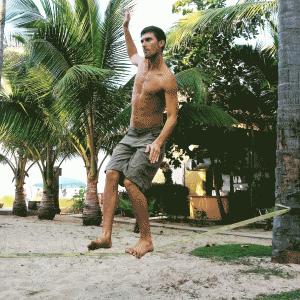Try these 5 simple tips so that you can successfully enjoy the benefits of barefoot running injury-free for years to come.
Start Running in More Minimal Running Footwear
Running in a thinner soled, light weight shoe with less of a heel will promote a more mid-foot landing similar to how your foot lands when running without shoes. There are many “natural” running shoes out on the market today that are an excellent tool for transitioning to barefoot running, while still getting the cushioning, grip, and protection to keep you happily running for miles. When I want to experience most of the joy and benefits of running barefoot but need a little protection, then I prefer the modern take on the ancient huarache design of Earth Runners. They offer a custom fit thin forming sole secured with comfortable nylon laces and a unique electrical grounding system. It’s also great to know that my contribution is helping children in India as a part of the company’s donation fulfillment to Seva Sandals- 1 pair for every 10 sold.
shoes out on the market today that are an excellent tool for transitioning to barefoot running, while still getting the cushioning, grip, and protection to keep you happily running for miles. When I want to experience most of the joy and benefits of running barefoot but need a little protection, then I prefer the modern take on the ancient huarache design of Earth Runners. They offer a custom fit thin forming sole secured with comfortable nylon laces and a unique electrical grounding system. It’s also great to know that my contribution is helping children in India as a part of the company’s donation fulfillment to Seva Sandals- 1 pair for every 10 sold.
If you just want a regular running shoe but stripped down to provide a more barefoot feel then there are tons of options for both road and trail shoes. Visit your local running store and try on several pairs to find out which ones fit you best and feel the most comfortable. You may even find that you’re quite happy running in minimal footwear and have no need or desire to go completely bare. That’s perfectly fine as you’ll still be experiencing most of the benefits and joy of natural running. See links at the end of the article for my shoe review videos and other running related videos I’ve made.
Go Barefoot More Often
Try being barefoot as often as you can to help you more quickly adapt to being barefoot.

Run on Soft Surfaces
This is especially important when first starting out. Running on soft surfaces such as grass, sand, or smooth trails will lessen the impact on your joints and muscles that you may be experiencing without the thick cushioning that most running shoes have. The soft surface will be much more forgiving, allowing you to run longer and adapt to barefoot running quicker.
Keep Your Runs Short
Running for short periods of time barefoot will help you adapt to it without the risk of over-use injuries or too much impact on your joints causing soreness. You can try running 2 or 3 times per day for only 5-10 minutes or so, giving you a higher total time/distance for the day, without the physical damage that happens from only one longer run. By slowly and consistently increasing the amount of time you run, you’ll be able to painlessly transition into barefoot running for longer distances.
 Cross Train
Cross Train

Doing other activities to improve your strength, balance, stability, and endurance will transfer over to barefoot running making you a stronger runner less prone to injury. Strength training can help equalize muscle imbalances, and decrease fatigue by improving muscle strength and endurance. Balancing exercises like slacklining, box jumps, and other sports are all great ways to improve foot, ankle, leg and core strength needed for barefoot running. Do these activities barefoot if you can as I mentioned in Tip #2. Better balance will also help you run over uneven surfaces and on challenging terrain with more confidence. For more information on balance and tips on how you can improve it see my article Better Balance = Better Fitness: 5 Tips to Improve Your Balance.
Using these tips will give you a much easier and safer transition to bare foot running. You will gain better form and become a stronger runner and a better all around athlete. If you have any questions about barefoot running or are interested in coaching to become a better runner and a fitter, healthier person then please contact me. If you have any barefoot running tips of your own that you would like to share please leave a comment!
Check out my Youtube Channel for running related videos, shoe reviews, training tips, natural movement workouts, diet and nutrition info, and more (Subscribe to my channel if you would like to see more!)
Kevin Park CPT
Kevin Park is the founder of wildbodywellness.com. He is a certified personal trainer specializing in natural movement, a natural lifestyle mentor, a long-term raw vegan, a runner, a bike racer, and a nature lover. His passion in life is to help people discover their natural wild bodies and achieve optimal health and wellness. He loves trail running with his dog, eating tropical fruits, reading good books, researching, and traveling with his partner.
wildbodywellness.com
facebook.com/wildbodywellness
youtube.com/wildbodywellness
